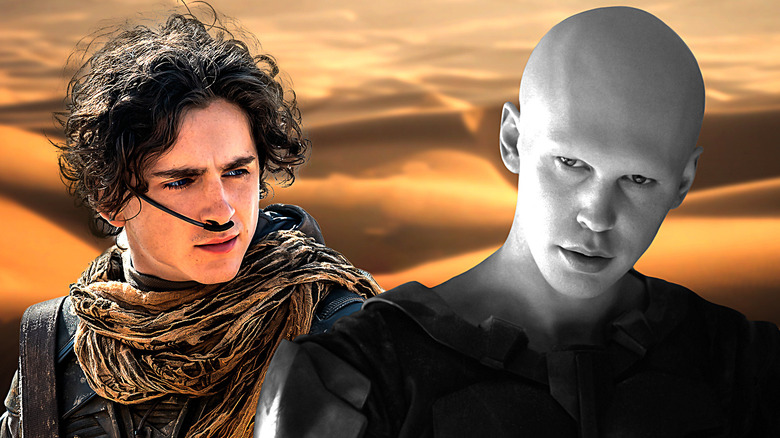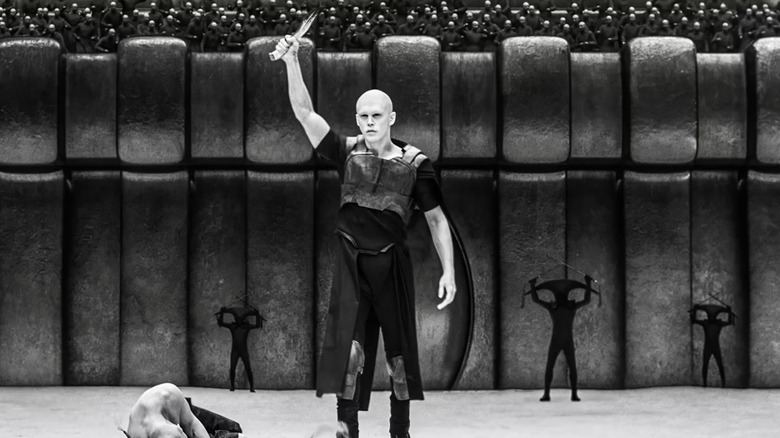Dune 2's Black And White Scene Had The Studio Panicking
Denis Villenueve approached his first "Dune" film by adapting only half of Frank Herbert's original novel, betting he could tell the story's second chunk in a sequel. This gambit paid off when "Dune" became a box office success, but it meant holding back some characters for "Part Two."
Among them was Feyd-Rautha Harkonnen, nephew of Baron Vladimir and Paul Atreides' (Timothee Chalamet) counterpart. Feyd made his debut in "Dune: Part Two" played by Austin Butler, and what a debut it was. Like in the book, Feyd celebrates his birthday in the gladiatorial pits of Harkonnen homeworld Giedi Prime, killing three drugged Atreides captives. If you want a taste of what a science-fiction version of "Gladiator" would look like, there you go.
Villenueve's realization of the scene is memorable for two reasons. One, Butler, who intuitively chooses to do an impression of Stellan Skarsgård — the actor playing his uncle — and nails his gravely Swedish accent (and people thought Butler's portrayal of Elvis Presley was uncanny). Two, unlike the rest of the "Dune" duology (certain to soon be a trilogy), Feyd's pit fight is shot in black-and-white.
This flourish gets a diegetic justification; Geidi Prime orbits a black sun, so all the light on the planet is grey-toned. Villenueve explained to Inverse: "The idea that the sunlight, instead of revealing colors, will kill colors; that [the Harkonnens'] own world will be seen in a daylight as a bleak black-and-white world, will tell us a lot about their psychology."
While this scene won over audiences, "Dune" cinematographer Grieg Fraser revealed in an interview with Screen Rant that it had Warner Bros. execs feeling uncertain.
Dune: Part II's black and white color wasn't added in post
The black-and-white color of Geidi Prime wasn't some post production color-grading. The scene was filmed using a digital camera modified to pick up infrared light. Once the filmmakers finished shooting the scene, they'd in effect cast their die on the color (or lack of it).
Fraser explained that the black-and-white scene was also the first part of "Dune: Part Two" filmed during principal photography. So, while the crew were in the middle of shooting more, they started getting phone calls from WB execs worried about the greyscale dailies:
"Suddenly, we're on phone calls going, 'Can we fix that? Can we fix it in post? Can we add color? How do we resolve this?' But we made a choice and just went, 'Well, we've made a choice. It's black and white, no color, we can't make it color. There's no way back. We've made a choice, and we're going one way.' So that, for me, was probably the biggest — I wouldn't say challenge, the biggest consideration, where we had no way home."
The filmmakers must have felt extra confident because, as Fraser told The Hollywood Reporter, they'd had doubts about the scene too. Fraser cited how several other recent films, specifically "Oppenheimer," "Poor Things," and "Belfast," were shot partially or entirely in black-and-white:
"When we talked first about Giedi Prime's sun having no color, we were effectively talking about shooting in black and white, and we asked ourselves that question: 'Is it a crutch? Is it a trend? Is it a thing if we did it in black and white? [...] Shooting in color is not a trend; it's just the way it is. But, unfortunately, because you're shooting in black and white, it can be seen as being a trend."
Evidently, they decided black-and-white was the best way to do it, trend or not. If something's a trend, after all, it's often for good reason. And once you silence the doubts in your own head, it's easier to stand confident against studio notes too.

